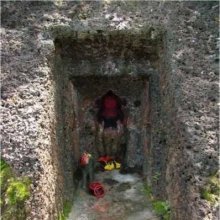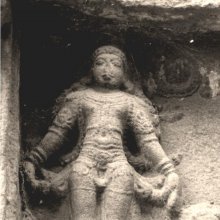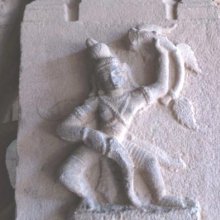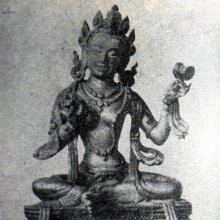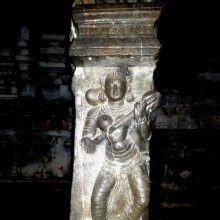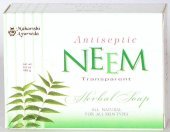Natural: 2 definitions
Introduction:
Natural means something in Hinduism, Sanskrit. If you want to know the exact meaning, history, etymology or English translation of this term then check out the descriptions on this page. Add your comment or reference to a book if you want to contribute to this summary article.
Images (photo gallery)
(+13 more images available)
In Hinduism
Natyashastra (theatrics and dramaturgy)
Source: Shodhganga: Elements of Art and Architecture in the Trtiyakhanda of the Visnudharmottarapurana (natya)1) The Natural Gait is denoted by the Sanskrit word Svābhāvika, which represents one of the various Gatis (“way of walking”) (in Indian Dramas), according to the Viṣṇudharmottarapurāṇa, an ancient Sanskrit text which (being encyclopedic in nature) deals with a variety of cultural topics such as arts, architecture, music, grammar and astronomy.— The word svābhāvika means natural. So, the term svābhāvikagati denotes natural gait. According to the Viṣṇudharmottarapurāṇa, in natural gait the knees are lifted up to waist.
2) The Natural (colour) is denoted by the Sanskrit word Svabhāvavarṇa and is associated with Śānta or the “quiet sentiment”, which represents one of the nine kinds of Rasa (“soul of Drama”), according to the Viṣṇudharmottarapurāṇa.—Śama is the sthāyibhāva of śānta-rasa. According to the Viṣṇudharmottarapurāṇa, the colour of śānta-rasa is recognized as svabhāvavarṇa i.e., natural colour. Paraḥ purūṣa is regarded as the god of this sentiment. But according to the Sāhityadarpaṇa, Śrīnārāyaṇa is the god of this sentiment.

Natyashastra (नाट्यशास्त्र, nāṭyaśāstra) refers to both the ancient Indian tradition (shastra) of performing arts, (natya—theatrics, drama, dance, music), as well as the name of a Sanskrit work dealing with these subjects. It also teaches the rules for composing Dramatic plays (nataka), construction and performance of Theater, and Poetic works (kavya).
Yoga (school of philosophy)
Source: ORA: Amanaska (king of all yogas): A Critical Edition and Annotated Translation by Jason BirchThe Natural (no-mind) state is denoted by the Sanskrit term Sahaja, according to the Amanaska Yoga treatise dealing with meditation, absorption, yogic powers and liberation.—Accordingly, as Īśvara says to Vāmadeva: “[...] Some have intellects which have become insensitive through reasoning and [philosophical] speculations, [and some] are elevated by [their] conceit and ego. Some are self-satisfied with pride, [rendered] stupid by [their obsession with] caste, and [some] are confounded by activities such as meditation. Generally speaking, the multitudes of people have deluded minds and various [mental] disturbances, for, those who experience nothing but the bliss of the undisturbed, natural (sahaja) [no-mind] state, are not seen in the world. [...]”.

Yoga is originally considered a branch of Hindu philosophy (astika), but both ancient and modern Yoga combine the physical, mental and spiritual. Yoga teaches various physical techniques also known as āsanas (postures), used for various purposes (eg., meditation, contemplation, relaxation).
See also (Relevant definitions)
Starts with: Natural Morality, Natural phenomenon, Natural purity, Natural rubber, Natural state, Natural talk.
Full-text (+3295): Sahaja, Svabhavika, Svabhava, Prakrita, Nisarga, Akritrima, Svarupa, Anuloma, Naisargika, Akhata, Prakritika, Samsiddhika, Prakritistha, Anulomya, Akalpita, Ashvamahishika, Jalancala, Autpattika, Svarupata, Bhavika.
Relevant text
Search found 447 books and stories containing Natural; (plurals include: Naturals). You can also click to the full overview containing English textual excerpts. Below are direct links for the most relevant articles:
The World of Beauties < [January – March, 2004]
Spencer's Theory of Rights < [April 1969]
Whom Am I Responsible To < [April – June, 2007]
Shishupala-vadha (Study) (by Shila Chakraborty)
Content of the Śiśupālavadha < [Introduction]
Conception about Friend and Foe < [Chapter 1 - Concept of Vijigīṣu king]
Spy in the Śiśupālavadha < [Chapter 4 - Activities of spy]
Shukra Niti by Shukracharya (by Benoy Kumar Sarkar)
Chapter 4.1 - Characteristics of Friends
Chapter 4.2 - Treasure and Wealth
Manusmriti with the Commentary of Medhatithi (by Ganganatha Jha)
Verse 10.25 < [Section II - Mixed Castes]
Verse 10.31 < [Section II - Mixed Castes]
Verse 10.41 < [Section III - Status of the Mixed Castes]
Conditions (by Nina van Gorkom)
Chapter 8 - Decisive Support-condition Part 2
Chapter 10 - Repetition-condition
Bhagavati-sutra (Viyaha-pannatti) (by K. C. Lalwani)
Part 2 - Acquisition of matter—by cloth and by soul < [Chapter 3]
Part 1 - On the transformation of matter < [Chapter 1]
Part 3 - On the state of being and state of non-being < [Chapter 3]
Related products
(+530 more products available)
